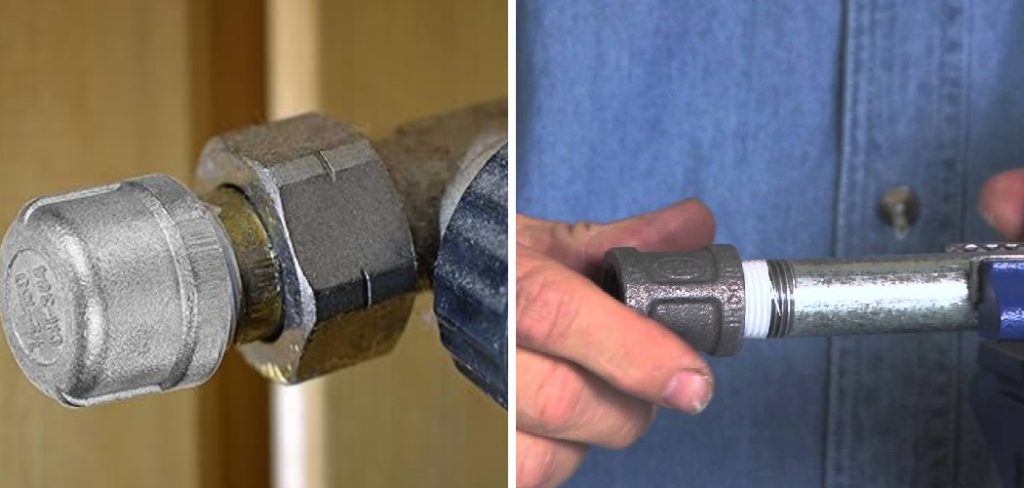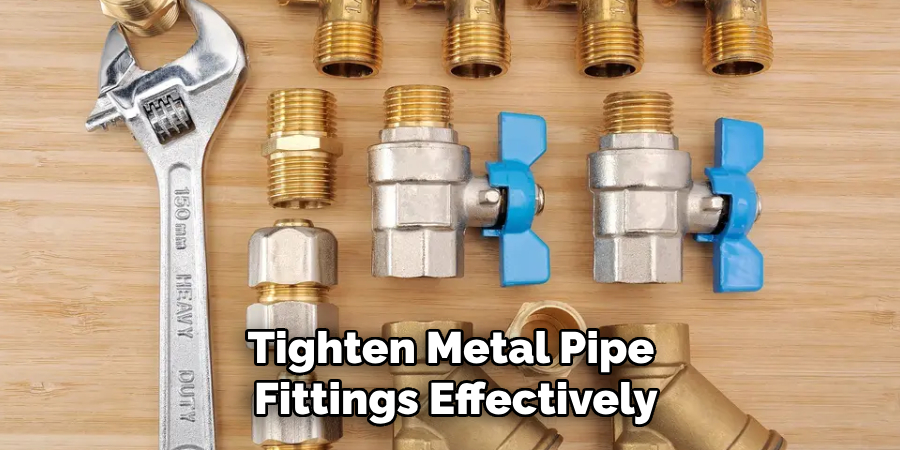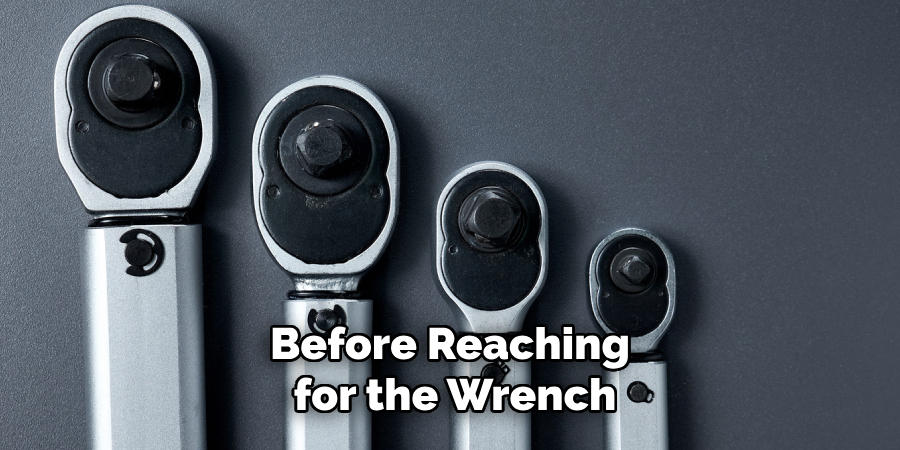Tightening metal pipe fittings is a crucial step in ensuring a secure and leak-free plumbing system. Whether you are working on a residential plumbing project or an industrial installation, achieving the right level of tightness is essential to prevent leaks and maintain system integrity.

This guide on how to tighten metal pipe fittings will walk you through the necessary tools and techniques, offering helpful tips along the way to make the process straightforward and efficient. Understanding the nuances of different fitting types and materials will also empower you to tailor your approach, ensuring a snug fit every time.
Why is Tightening Metal Pipe Fittings Important?
Before we delve into the methods of tightening metal pipe fittings, it’s crucial to understand why this step is necessary. A poorly tightened fitting can result in leaks, leading to water damage and costly repairs. It can also cause disruptions in the flow of fluids or gases within a system, impacting its overall efficiency.
Moreover, inadequate tightening can cause fittings to loosen over time, leading to leaks or even complete system failure. A leak in a gas or chemical system can also pose safety hazards for both the environment and individuals working with the system.
Tools Required
To tighten metal pipe fittings effectively, you will need some basic tools that are readily available at most hardware stores. These include:
Pipe Wrench or Adjustable Wrench:
This will help you grip and turn pipes and fittings securely. It is essential to choose a wrench that fits the size of the pipe or fitting you are working on.
Pipe Tape:
Also known as thread seal tape, it is used to create a watertight and airtight seal between threaded pipe fittings. It is particularly useful for tapered threads, which can be prone to leaks if not sealed properly.
Teflon Paste or Pipe Dope:
This is another sealing agent that can be applied to the threads of pipe fittings before tightening. It has a paste-like consistency and provides an additional layer of protection against leaks.
8 Step-by-step Guidelines on How to Tighten Metal Pipe Fittings
Step 1: Prepare the Pipe and Fittings
Before you begin tightening your metal pipe fittings, it is crucial to properly prepare both the pipe and fittings to ensure a secure connection. Start by cleaning the threads of the pipe and fittings thoroughly to remove any dirt, debris, or old sealing material. This can be done using a wire brush or a clean cloth.

Ensuring that the threads are clean will help the sealant adhere better and prevent any obstruction that may cause leaks. Once cleaned, inspect the metal for any signs of damage, such as cracks or deformities, and replace any compromised parts before proceeding. Proper preparation sets the stage for an effective fitting process, reducing the likelihood of complications further down the line.
Step 2: Wrap the Thread with Pipe Tape
Once the pipe and fittings are clean and free from debris, the next step is to wrap the threads with pipe tape to ensure a tight seal. Start by holding the end of the tape against the threads at the joint end of the pipe. Wrap the tape around the threads in a clockwise direction, ensuring that it overlaps slightly with each pass.
This will prevent the tape from unraveling during the installation process. Typically, two to three layers of tape are sufficient to create an effective seal but ensure it is not too bulky, which may hinder proper threading. Carefully tear off the tape once you have reached the end, and press it snugly against the threads. Pipe tape is a vital component in preventing leaks by filling in tiny gaps in the threads, thus providing an additional layer of protection against fluid or gas escape.
Step 3: Apply Teflon Paste or Pipe Dope
If you prefer using a pipe sealing paste, this is the stage where it should be applied. Using a clean brush, carefully coat the threads of the fitting with an even layer of paste. Be sure to cover all areas thoroughly, as any gaps can compromise the seal and lead to leaks.
Ensure that you do not apply too much paste, as excess can squeeze out during tightening and create a mess or interfere with proper threading. If using Teflon paste, note that it is thicker than tape and will require more force when tightening the fittings.
Step 4: Hand-tighten Fittings
Before reaching for the wrench, try hand-tightening the fittings first. This will give you a sense of how tight they need to be before using further force.

Hand-tighten by gripping the pipe and turning it clockwise while holding the fitting steady with your other hand. Use enough pressure to create a snug fit, but do not overtighten, as this can damage the threads or lead to leaks.
Step 5: Begin Tightening with a Wrench
Once you have hand-tightened the fittings, use a pipe or adjustable wrench to turn them an additional quarter or half-turn. This tightening method is known as “snug-fit” and ensures that the seal is secure without damaging the threads.
Avoid overtightening, as this can cause damage to the fittings and potentially create leaks.
Step 6: Check for Leaks
After tightening with a wrench, it is essential to check for any signs of leakage before considering the job complete. Use a small amount of water or soap solution and apply it to the joint area. If bubbles appear, it is an indication that the fitting is not tight enough and may require additional tightening.
You can also use a pressure gauge to ensure that the system is maintaining proper levels and there are no leaks.
Step 7: Repeat Process for Multiple Fittings
If you have multiple fittings in your system, follow the same steps for each one. Be sure to clean and prepare each fitting before applying pipe tape or paste and hand-tightening.
This will ensure consistency in tightening and reduce the risk of leaks.
Step 8: Re-check Periodically
Even with proper initial tightening, it is essential to periodically check your metal pipe fittings for any signs of loosening or potential leaks. This becomes particularly crucial if your system experiences high-pressure changes or vibrations.
Make it a habit to inspect your fittings regularly, and take necessary action if you notice any issues. This will help maintain the integrity of your system and prevent any major problems in the long run.
Following these guidelines on how to tighten metal pipe fittings will help you properly tighten your metal pipe fittings and ensure a secure, leak-free connection. Remember to always use the correct tools and equipment, clean and prepare the fittings thoroughly, and check for leaks before considering the job complete. With proper tightening techniques, your metal pipe fittings can provide a reliable and long-lasting solution for various plumbing or industrial applications. So keep these steps in mind next time you need to work with metal pipes! Happy fitting!
Do You Need to Get Professional Help?
While tightening metal pipe fittings can be a straightforward task with the right tools and guidelines; there are certain situations where seeking professional help might be advisable. If you are dealing with a complex piping system, such as those involving gas lines or high-pressure applications, it is essential to consult with a professional who has the expertise and knowledge to handle the job safely.

Additionally, if you encounter persistent leaks or find damage during the inspection process that may require more than simple tightening, a professional plumber can assess and address the issue effectively. Investing in professional help not only ensures the integrity and safety of your piping system but can also save you from potentially costly repairs in the future.
Frequently Asked Questions
Q: How Tight Should Pipe Fittings Be?
A: Pipe fittings should be tightened enough to create a secure and leak-free connection, but not so tight that it damages the threads or compromises the seal. A quarter or half-turn with a wrench after hand-tightening is typically sufficient.
Q: Can Pipe Tape Be Reused?
A: No, pipe tape should not be reused. Once it has been applied and wrapped around the threads, it will adhere to itself and cannot be easily removed without damaging the seal.
Q: How Often Should You Check Metal Pipe Fittings for Tightness?
A: It is recommended to periodically check your metal pipe fittings for tightness, especially if your system experiences high-pressure changes or vibrations. This could be once a month or more frequently depending on the application. However, if you notice any issues such as persistent leaks or damage to the fittings, it is essential to address them immediately. It is better to be proactive in checking and addressing any problems rather than risking major issues down the line.
Q: Can I Use Pipe Tape and Paste Together?
A: While it is not necessary to use both pipe tape and paste together, some people prefer using a combination of the two for extra sealing protection. If you choose to do so, remember to apply the paste first and then wrap the tape over it.

Conclusion
Properly tightening metal pipe fittings is an essential aspect of ensuring a safe and functional plumbing or gas system. By following these step-by-step guidelines on how to tighten metal pipe fittings and using the right tools, you can tighten metal pipe fittings effectively and minimize the risk of leaks. Remember to always prepare the surfaces properly, use sealing agents such as tape or paste, hand-tighten before using a wrench, and periodically check for leaks to ensure the longevity of your system. With diligence and care, you can achieve secure connections that will serve you
Edmund Sumlin is a skilled author for Metal Fixes, bringing 6 years of expertise in crafting a wide range of metal fixtures. With a strong background in metalwork, Edmund’s knowledge spans various types of fixtures, from decorative pieces to functional hardware, blending precision with creativity. His passion for metalworking and design has made him a trusted resource in the industry.
Professional Focus:
- Expert in Metal Fixtures : Edmund aesthetic specializes in creating durable and innovative metal fixtures, offering both appeal and functionality. His work reflects a deep understanding of metalworking techniques and materials.
- Sustainability Advocate : He is dedicated to using sustainable practices, ensuring that every fixture is crafted with eco-friendly methods while maintaining high-quality standards.
In his writing for Metal Fixes, Edmund provides valuable insights into the latest trends, techniques, and practical advice for those passionate about metal fixtures, whether they are professionals or DIY enthusiasts. His focus on combining artistry with engineering helps others discover the true potential of metal in design.


